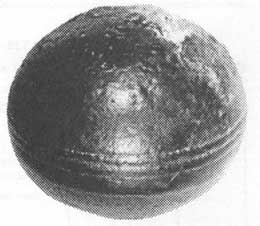- Joined
- Aug 7, 2001
- Messages
- 54,631
From a UFO website, and includes dodgy grammar and spelling....
Who Made the Giant Stone Spheres?
By UFO Area
Copyright © 2000 - 2007 UFO Area
March 9, 2007
--------------------------------------------------------------------------------
Are the mysterious giant stone spheres of unknown age representations of planets and moons of the solar system?
If the stone balls had been left at the original place, would they form a gigantic planetarium?
Some scientists suggest that the ancient spheres are natural formations, others believe these round-shaped stones are man-made and a third group propose that the stone spheres were made by extraterrestrials, the inhabitants of Atlantis or perhaps an advanced lost civilization.
Although many theories have been put forward, nobody really knows when or how these ancient stone spheres were made, by whom, or for what purpose.
Most famous of the ancient stone balls are the Costa Rican spheres, but unique round stone balls have also been found in Mexico, Aruba, Haiti. Not so long ago, similar artifacts were also discovered in Bosnia.
In 1945, Matthew Williams Stirling, an American antropologist and archaeologist who spent most of his career at the Smithsonian Institution, discovered a large number of stone spheres in Mexico. They were almost perfectly spherical. Later in the vicinity of Palamer Sur, Costa Rica, Stirling found more stone spheres.
The stone balls measured the size of an adult in diameter and were made of granite. They were not scattered around the area, but seemed to be placed deliberately in a specific formation. At first Stirling suspected the stones were made by an unknown civilization. However, when he and his colleagues discovered later a large number of similar spheres, some measuring up to two meters in diameter in other parts of Mexico, the scientists concluded the stones were of geological origin. In the scientific report, it stated that the round stones were formed by high temperature nucleation of glassy material around glass shards within an ashfall tuff, as a result of tertiary volcanism.
This is a never-ending problem in the scientific community. Whenever an anomalous artifact is unearthed that do not fit the traditional picture, it is very often explained as a work of nature.
Can "nature" produce so many such perfectly round-shaped spheres? Hardly.
In Costa Rica, archaeologists have identified and catalogued hundreds of the balls. If you visit the country, you can view them in museums. Some of them have been placed as decorations around more important official buildings, hospitals and in parks. The majority of the stones were moved across the country and only six stone balls are known to remain in their original positions.
To determine the origin of the Costa Rican spheres is difficult. They are perfectly round-shaped, polished, very large, weigh many tons, and composed of solid hard rock.
Searching for clues to their origin and dating is difficult. No one knows exactly how old the balls are, because Costa Rica had no recorded history before the arrival of Columbus in 1502.
Researchers have tried to obtain information on the spheres from the local inhabitants. However, the spheres were previously unknown to them and they could offer no explanation of who made them, how old they were and for what purpose they were constructed.
Some experts suggest that the stones are actually man-made.
If this is correct, then the ancient people must have been technologically very advanced and skilled mathematicians. The spheres are so perfectly round that not even modern equipment could have produced something with such precise tolerances. How could such massive stones be moved a long distance without modern transportation? Were they rolled downhill? For hundreds of miles around there was no querry from where they could have come. Where they really rolled through the jungle to the tops of the mountains? It would certainly take a decade to complete such a demanding task.
Some researchers like Professor Ivar Zapp and anthropologist George Erikson became interested in the Costa Rica stone spheres.
Professor Zapp was convinced that the spheres could not be attributed to the Chorotega Indians, as academics maintained. The Chorotega did not have adequate tools or capability to construct perfect spheres of this magnitude. Zapp's and Erikson's investigation led them to believe that these spheres are 12,000-year-old artefacts constructed by a technically advanced sea-going culture. The spheres were in their opinion used as navigational markers. According to the scientists, this ancient culture can be traced all the way back to Atlantis.
American archaeologist Samuel K Lothrop, who studied the spheres, theorized that the stones were placed in 'astronomically-significant' alignments.
Examination of the formations revealed that three, four or five of the large stone balls were arranged in a straight line, serving as a base for triangles and other geometrical figures. It was obvious that the whole arrangement obeyed mathematical laws.
Was the purpose of the formations to represent constellations or stellar maps?
The Books of Prophecy of the Chorotegan priests may hold a clue to the origin of the mysterious stone spheres…
The legend tells of how early human civilizations were looked after by beings from outer space. According to the legend, one day in the future modern man will also reach the stars. The Books of Prophecy say that those who descended from the heavens were the "jaguar-men". In fact, we do encounter depictions of jaguars all across America.
Archaeologist Semir Osmanagic discovered the Bosnian stone balls.
He believes that the creators of the spheres in Mexico, Costa Rica and Bosnia used the same technology and the similarities are striking.
This shows there is a connection between the American stone balls and the ones found in Bosnia.
Only a small number of spheres have been found in Bosnia and there is a possibility that many more might be discovered in the near future.
The large, polished, ancient stones show us how little we know of our history and the questions remain: Who made them? Why and how?
http://www.ufoarea.com/aas_giantspheres.html



